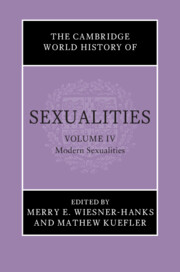Book contents
- The Cambridge World History of Sexualities
- The Cambridge World History of Sexualities
- The Cambridge World History of Sexualities
- Copyright page
- Contents
- Figures in Volume IV
- Contributors to Volume IV
- Editors’ Preface to the Series
- 1 Sexuality and Capitalism
- 2 Colonialism and Modern Sexuality
- 3 Gender, Migration, and Sexuality in the Modern World
- 4 ‘Pornography’, ‘Obscenity’, and the Suppression of Libertine Literature
- 5 Sexuality and the Print Media in the Modern World
- 6 Eugenics, Public Health, and Modern Sexuality
- 7 Sexuality and Consumerism in the Modern World: The Business of Pleasure
- 8 Sex Education in the Modern World
- 9 Birth Control and Reproductive Rights in the Modern World
- 10 The Impact of the World Wars on Modern Sexuality
- 11 Sexualities and Dictatorships of the Twentieth Century
- 12 Sexuality in Post-war Liberal Democracies
- 13 The Sexual Revolution
- 14 Sex Tourism: Fluid Borders of Meanings and Practices
- 15 The History of AIDS since 1981: Medicine, Politics, and Societies in a Pandemic
- 16 Sex Trafficking in the Modern World
- 17 Sex, Law, and Domestic Violence against Women in the Modern World
- 18 Sexuality under Attack Now
- Index
- Contents to Volumes I, II, and III
- References
3 - Gender, Migration, and Sexuality in the Modern World
Published online by Cambridge University Press: 26 April 2024
- The Cambridge World History of Sexualities
- The Cambridge World History of Sexualities
- The Cambridge World History of Sexualities
- Copyright page
- Contents
- Figures in Volume IV
- Contributors to Volume IV
- Editors’ Preface to the Series
- 1 Sexuality and Capitalism
- 2 Colonialism and Modern Sexuality
- 3 Gender, Migration, and Sexuality in the Modern World
- 4 ‘Pornography’, ‘Obscenity’, and the Suppression of Libertine Literature
- 5 Sexuality and the Print Media in the Modern World
- 6 Eugenics, Public Health, and Modern Sexuality
- 7 Sexuality and Consumerism in the Modern World: The Business of Pleasure
- 8 Sex Education in the Modern World
- 9 Birth Control and Reproductive Rights in the Modern World
- 10 The Impact of the World Wars on Modern Sexuality
- 11 Sexualities and Dictatorships of the Twentieth Century
- 12 Sexuality in Post-war Liberal Democracies
- 13 The Sexual Revolution
- 14 Sex Tourism: Fluid Borders of Meanings and Practices
- 15 The History of AIDS since 1981: Medicine, Politics, and Societies in a Pandemic
- 16 Sex Trafficking in the Modern World
- 17 Sex, Law, and Domestic Violence against Women in the Modern World
- 18 Sexuality under Attack Now
- Index
- Contents to Volumes I, II, and III
- References
Summary
This chapter highlights issues around sexuality and migration. It examines more closely one particular type of migration, with a comparative analysis of migrations from southern Italy, China, and western India to the Americas, Africa, and South Asia in the nineteenth and early twentieth centuries, and the women who were left behind by this migration. Traditional research on historical migrations has provided male-centred perspectives regarding motives, settlement, identity, and citizenship. Recent studies have sought to alter these perspectives by shifting women”s narratives from the margins to the centre in the context of agency, sexuality, and masculinity. Thus this chapter problematizes the sexual economy not only of the “women left behind” in the migration process but also that of their spouses and partners. It reveals how gender shapes migration and how migration defines gender relations. It alludes to attitudes and perceptions about gender and sexuality in a diverse geopolitical context, how the intersectionality of sex and emotions frames mobility behaviour and challenges sexual norms. It thus shifts the nexus between gender, sexuality, and migration to the centre of historical analysis rather than situating it at the margins.
- Type
- Chapter
- Information
- The Cambridge World History of Sexualities , pp. 50 - 70Publisher: Cambridge University PressPrint publication year: 2024



